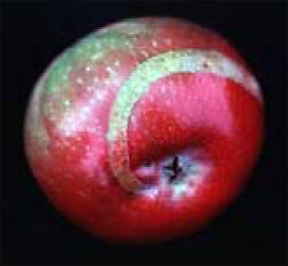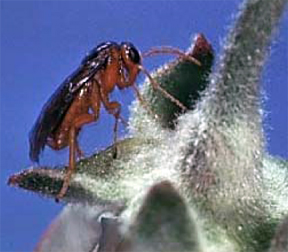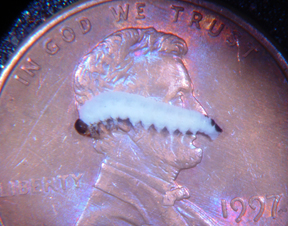European apple sawfly damage found in southeast Michigan apple orchards
The European apple sawfly can damage apple in three ways: a brownish discoloration to the receptacle or sepal from egg-laying, first instar larval scarring of the fruit and deep entries into the fruit.
Editor’s note: This article is from the archives of the MSU Crop Advisory Team Alerts. Check the label of any pesticide referenced to ensure your use is included.
Pop quiz: The larvae of which insect tunnel into the center of an apple and feed on apple seeds, producing a tell-tale, frass-filled hole in the apple? If you were to answer, the codling moth, you would be correct, but in this case we received phone calls from a few southeast Michigan fruit growers asking us to look at damage on apples long before first generation codling moth larvae appeared in the orchard. Samples from two Michigan farms were confirmed to contain larvae of the European apple sawfly, a pest of apple more commonly found in New York and Ontario apple orchards.
Entomologist, Art Agnello, of the NYSAES Geneva station, reports that European apple sawfly has been a problem in southeastern New York orchards since its introduction in 1940, and has been steadily extending its range westward across the state in the past five years. The European apple sawfly can damage apple in three ways: a brownish discoloration to the receptacle or sepal from egg-laying, first instar larval scarring of the fruit and deep entries into the fruit.
A newly hatched sawfly larva begins feeding on the fruit skin, resulting in a winding, ribbon-like, heavily russeted scar that generally spirals out from the calyx end of the apple (Photo 1). If the apple does not abort during June drop, this damage can result in downgraded fruit at harvest. Deep entries into the fruit resemble injury caused by codling moth, but whereas a codling moth larva will damage a single fruit, New York colleagues report that a single sawfly larva can tunnel into multiple fruit within a cluster. Since this damage is incurred around petal fall, fruit with internal feeding typically abort during June drop.
European apple sawfly overwinter as mature larvae in the soil, just below the soil surface. Larvae pupate in the spring and adults emerge during the pink stage of apple growth. Females lay eggs at the calyx end of the flower, often at the base or between the stamens just after the king bloom opens. Larvae emerge after about ten days. European apple sawflies have one generation a year, and the larvae generally mature in four to six weeks upon leaving the fruit. At full maturity, larvae burrow into the soil to form a cocoon for the rest of the summer and through the winter. The diapause stage may last up to two years.
Unlike codling moth, the European apple sawfly is a wasp, not a moth. Adults are 6-8mm long with brown bodies, yellow heads and antennae, and black eyes (Photo 2). Upon hatching, larvae are about 2 mm in length and cream-colored with black head capsules. They possess a shield-like plate at the tail end. Larvae increase in size up to 11 mm in length, and the head and shield turn pale brown at full maturity (Photo 3).
Our New York colleagues report that European apple sawfly adults can be scouted with white sticky boards set at tight cluster and placed at eye level on the south facing sides of perimeter trees. The traps should be scouted regularly through petal fall to determine the need and timing to control this pest. Insecticide treatments are generally timed pre and postbloom and can be complicated by the presence of bees in the orchard for pollination. Both the sawfly and bees are hymenopteran insects (wasps), and materials targeting the sawfly can adversely affect bees.
We encourage apple growers across the state to keep an eye out for damage from the European apple sawfly as they are working in the orchard this summer and while harvesting apples in the fall. If you find scarred apples at harvest, be on alert to do a thorough job of trapping and scouting for adults in the spring to prevent populations from building. It’s uncertain whether Michigan growers will begin to see more damage occurring from this pest, but the presence of damaged apples in a few Michigan orchards this year should put growers on the alert to monitor for this pest in coming years. The experience in New York State is that the European apple sawfly is moving westward.



 Print
Print Email
Email







